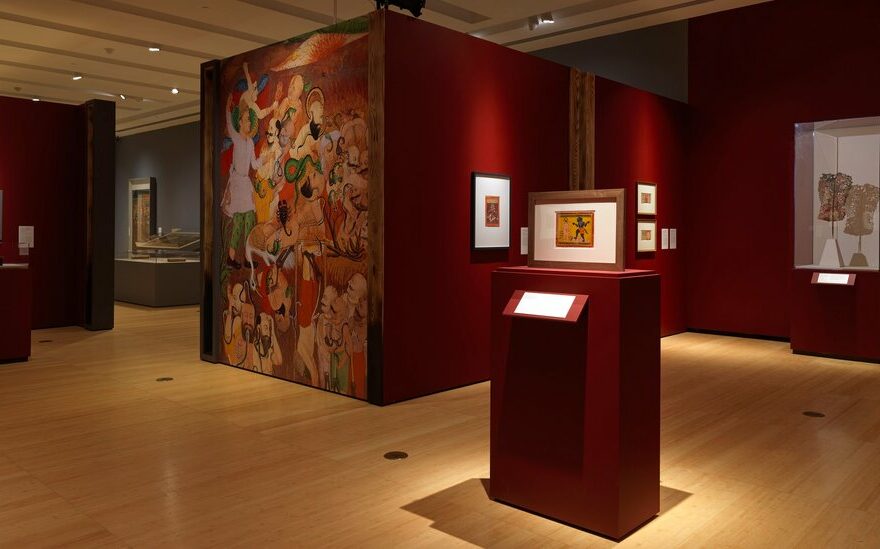Vivid illustrations of the underworld are currently on view at the Asia Society, where in a new exhibition the dead dance among the flames in illustrated manuscripts and other artworks, some dating to the 16th century.
The society describes its show, “Comparative Hell: Arts of Asian Underworlds,” as the first comprehensive exhibition in the United States to showcase images of eternal damnation from the religious traditions of Buddhism, Jainism, Hinduism and Islam.
But the presentation of two of the images, pages from illustrated manuscripts that depict the Prophet Muhammad, have ignited debate. Those images were blurred out on the museum’s online tour of the show, a decision that several scholars, including the director of a museum that lent one of the manuscripts, have described as concerning.
“I am highly surprised to see our painting ‘blurred’ on the website’s tour,” said Kjeld von Folsach, director of the David Collection, a museum in Copenhagen that lent a 15th-century manuscript depicting the blazing flames behind hell’s gates during the night of the Prophet Muhammad’s celestial ascension.
“This is a major work of art from our institution and we have not been told or asked about this,” he said.
The society says it was all a mistake, and has removed the online tour from its website to unblur the images.
“The virtual tour was created by an outside contractor without sufficient oversight,” Peggy Loar, the Asia Society’s interim vice president for global arts and culture, said in a statement. “Our goal with this exhibition has always been to display these historic works fully while also including necessary context and information. The images should not have been blurred, and we take responsibility for this error, but this was not an active choice to censor and is being corrected.”
Although the Quran does not explicitly prohibit images of the Prophet Muhammad, most Muslims view representations of him as sacrilegious, out of concern that such images could lead to worshiping the prophet rather than the God he served. Some historians have noted, though, that Islamic traditions are not uniform, and that groups who created the illustrated manuscripts nearly four centuries ago had different views.
Still, art historical representations of the Prophet Muhammad in various settings remain a flashpoint for debate about matters involving religious respect, free speech and academic liberty.
Edward Ahmed Mitchell, the deputy executive director of the Council on American-Islamic Relations, said in a phone interview that “the perspective held by most Muslims, not only in today’s times but historically, is that it is not permissible to draw an image of the Prophet Muhammad or any other prophet of God.”
“We encourage institutions not to show images of him out of respect for the Muslim community’s sentiments,” he said, “but we do not consider the display of those images to be inherently Islamophobic.”
Last year, at Hamline University, a private college in Minnesota, an adjunct professor who showed an image of the Prophet Muhammad during class lost her teaching job after a student complained. Officials sent emails to students and faculty saying what happened was clearly Islamophobic. Hamline’s president co-signed an email that said respect for the Muslim students “should have superseded academic freedom.” The school later walked back its comments after the teacher, Erika López Prater, sued for religious discrimination and defamation.
At the Asia Society, the exhibition occupies two floors and contains dozens of artworks and sacred artifacts that explain the mythology and belief systems of several religions. The manuscript images featuring the Prophet Muhammad are in galleries where signs warn against any photography of those images, and there is additional text designed to alert viewers to the subject matter in case they want to avoid looking at them.
“While these artworks, drawn from within the aesthetic traditions of Islam, may be viewed differently from a modern perspective,” the text reads, in part, “they were created at a time when such images were acceptable within the realms they were made.”
Christiane Gruber, a professor of Islamic art at the University of Michigan who advised on the exhibition, said she was not told of the decision to blur the manuscripts online or of the signs banning photography near the artworks.
“It’s a breach of ethics because these lending institutions expect the Asia Society to treat objects with care and respect,” said Gruber, who also wrote an essay in the exhibition catalog. “These images were not made to offend, but to laud the prophet.”
In a second artwork, lent by the Arthur M. Sackler Museum at Harvard University, the veiled Prophet Muhammad is shown kneeling below a green banner of mercy as he intercedes on behalf of the deceased during the Day of Judgment. The Sackler Museum did not respond to a request for comment.
Remarking on the veil, Gruber said some Muslim artists in the 16th century chose to depict the Prophet Muhammad’s purity through the use of white fabrics covering his face, which conveys a radiant light and veiled mystery because of contact with God.
Images in the Asia Society Show
Here are two artistic depictions of the Prophet Muhammad that were initially blurred in the online tour of a new exhibition at the museum. →
“Day of Judgment,” a folio from a manuscript of the “Falnama” (“Book of Omens”), circa 1555, is from the collection of the Arthur M. Sackler Museum at Harvard University.
“The Prophet Muhammad at the Gates of Hell,” a painting in a manuscript copy of al-Sara’i’s “Nahj al-Faradis” (”Paths of Paradise”) circa 1465, is on loan from The David Collection in Copenhagen.
Source: Read Full Article
